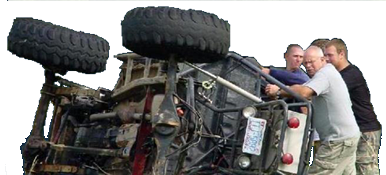- Joined
- Sep 28, 2009
- Location
- Concord, NC
Judging from the photo, you have the rig parked too far forward on the trailer.
Find out how much pin weight you've got and what the loaded trailer weight is. You can't do anything else until you know that, anyway.
I no longer park the jeep that far forward. The back bumper is now even with the rear of the trailer and I strap to the axles. However, with it loaded that way the sag on the truck is about the same. I'm not going to buy a scale so I'll see if I can find someone close who has one or perhaps take it to a trailer/rv place.
The truck may be wired for a brake controller already, not sure on the 1/2 tons though. My 03 3500 is, it requires a pigtail that plugs in under the dash then the brake controller gets spliced into that. The weight dist hitch, and controller can be had at redneck in lincolnton. or camping places but they are proud of their stuff.
I like you list as it is... I think the WD hitch will help out alot... you can get them online or at any trailer/RV places, like said...
also, depending on your trailer, you can get brakes/braking axles fairly cheap ($1-200 per), and with the right brake controller, should be plug & play (assuming you have factory 7 pin plug & towing package)
I should think it's wired for a brake controller already because it does have the 7 pole round connector from factory. Perhaps I can save some loot on the install and do this myself. Sounds pretty easy, plus I can have the heat going!

That may be an option as well. The trailer is a 1993 so was considering a newer one. I looked into putting brakes on it at one time but by the time it's said and done I figured I'd be spending a minimum of $500. Plus I wanted to remove the tubing on the exterior and the wheel wells so I could haul wider things. If I consider the parts and labor I would have about $1500 in the trailer. If I can get a newer equipment trailer with brakes for less than $1500, I kind of felt that was a better route. I should be able to get at the very least $500-$600 for my trailer in the current condition. Whatcha think? Never imagined there would be so many optoins to choose from.can't you add brakes to that trailer ? I was able to add brakes to a 3500# non-brake axle on my first trailer. It was a 'utility' trailer and looked similar to yours. Mine didn't even have the flange to bolt the backing plates to. Tractor-Supply (not agri-supply) had the flanges to weld on for $6. Bolted on standard brakes.
The reason I say this might be a good route is. Most car trailers are 2200# or more depending on construction/length etc. That utility trailer I had was only 12' but was light at 1200# If you can add some brakes and keep the weight down every little bit helps. AND you already have the trailer...
Also you can get a weld on 2-5/16" coupler at Agri-supply for like $30. That would be a good upgrade for using the WD hitch.
Find out your TW thats gonna help decide which direction you need to go...
You might want to load up the XJ on the trailer and take the whole deal up to the trailer place. If you have the winter time lazies that would be the best bet. If you've done all that work on your jeep then this shouldn't be a problem. Go to etrailer.com and they have a few videos on installing a weight distribution hitch. Looks pretty straight forward.
I'm positive I could do it myself. The problem is it's cold as crap outside and my truck won't fit in my narrow garage.

Regarding WD hitches with sway control. What is the difference between friction and dual cam? Which of these is best and why?
http://www.etrailer.com/dept-pg-Weight_Distribution-sf-WD_With_Sway_Control.aspx


